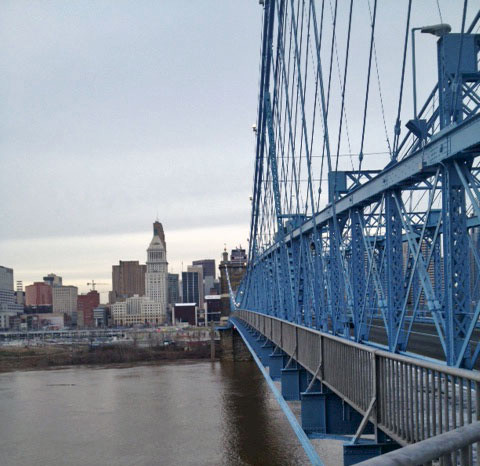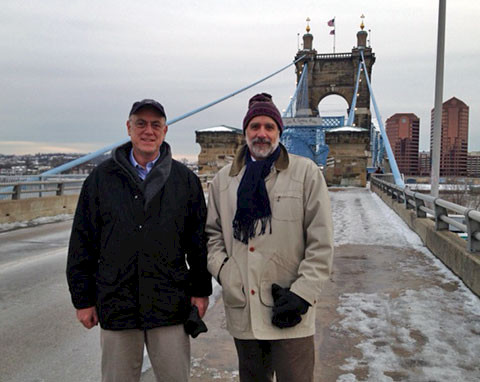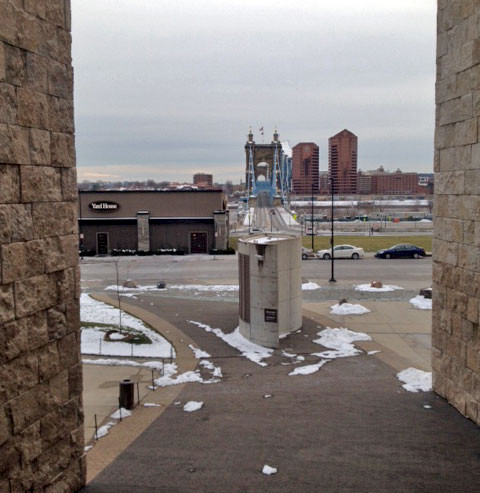Roebling Bridge in Cincinnati--the predecessor to the Brooklyn Bridge
Bill Dennison ·We had beautiful views of the Roebling Bridge from our workshop developing a Mississippi River report card in Covington, Kentucky. After the workshop was over, Bill Nuttle and I walked across the Roebling Bridge from Kentucky to Ohio. The Roebling bridge was built during the Civil War and completed in 1866. At this time, it was the longest suspension bridge in the world, although now there are 121 longer suspension bridges in the world. The Roebling Bridge is credited as the predecessor to the Brooklyn Bridge, which spans the East River in New York and was completed in 1883. The engineering innovation that made the Roebling Bridge possible was the use of steel cables to form suspension cables. John A. Roebling (1806-1869) was a Prussian engineer who emigrated to the U.S. and pioneered the use of steel cables in construction. Roebling manufactured steel cable in New Jersey and used cable to build various bridges around the country.

The Ohio River was a major transportation corridor during the nineteen century. Hundreds of steamboats carried cargo and people up and down the river. There were several canals that connected the Ohio River to the Great Lakes, providing access from the Ohio River to both the Gulf of Mexico via the Mississippi River and the Atlantic Ocean via the St. Lawrence Seaway. The Ohio River basin was rich in resources that were highly desired by the east coast inhabitants. Gaining access to these resources stimulated the development of the Chesapeake & Ohio Canal and the Baltimore & Ohio Railroad.
The Ohio River formed an important cultural barrier. The states to the south of the Ohio River allowed slavery, but the states north of the river did not. The major religion to the south of the Ohio River was Southern Baptist, but Methodist and Catholicism dominated north of the Ohio River. The states north of the Ohio River were part of the corn belt and also adopted manufacturing, but south of the river remained largely agricultural and forested.

A requirement for building a bridge across the Ohio River in Cincinnati was that the support structures (towers) did not constrict the river's overcrowded steamboat traffic. This is what led to the need for a suspension bridge with a long span. Roebling was recruited to use his steel cables and construct a suspension bridge. The support towers were constructed with sandstone and limestone over the course of many years, with various interruptions, including the American Civil War. Roebling imported the wire for the steel cables from England and the cables were strung across the river and then raised to form the bridge. The original bridge was used by streetcars and pedestrians and it is now used by cars and pedestrians. My Cincinnati cousins called it the "Singing Bridge" as a result of the open grate deck that the cars drive over and the resulting 'singing' sound of the tires.

John A. Roebling went on to design the Brooklyn Bridge but did not see it to completion due to an unfortunate accident. As Roebling was surveying the location of the proposed Brooklyn Bridge in 1869, his foot was crushed by a docking ferry boat. From his injury and subsequent surgery, he developed tetanus and died of 'lock-jaw'. John Roebling's son Washington A. Roebling oversaw the completion of the Brooklyn Bridge, even though he suffered from decompression sickness, or the 'bends'. Washington Roebling and many of the construction crew worked in pressurized water tight compartments to build the support tower foundations on the river bottom. They did not know that rapid reductions in pressure cause the nitrogen dissolved in the blood to form bubbles which block blood flow and cause tissue damage. They called this 'cassion disease', since they related it to the underwater structures (cassions). Washington Roebling's wife Emily Warren Roebling assisted her husband for 11 years to complete the Brooklyn Bridge, since he was incapacitated due to cassion disease. As a historic footnote, their nephew and Washington Roeblng's namesake, Washington A. Roebling II, was a victim of the sinking of the HMS Titanic in 1912.

At the Cincinnati end of the Roebling Bridge is the National Underground Railroad Freedom Center. The Freedom Center had magnificent views of the Roebling Bridge, and the significance of crossing the Ohio River was made more poignant when we saw the conditions that the African-American slaves were subjected to south of the Ohio River. Cincinnati was an important destination for the slaves smuggled out of slavery to freedom via the series of safe havens, known as the 'Underground Railroad', so the location of the museum next to the Roebling Bridge is quite apropos. The Freedom Center not only covered the American slavery period, but made a strong point that slavery is still rampant in various parts of the world.
One of the benefits of a project like the Mississippi River report card is the opportunity to visit interesting places and learn about the natural and cultural resources in different locations. The Roebling Bridge spanning the Ohio River is one of those fringe benefits.
About the author
Bill Dennison

Dr. Bill Dennison is a Professor of Marine Science and Vice President for Science Application at the University of Maryland Center for Environmental Science.
Next Post > Developing a Mississippi River report card: Ohio River workshop in Cincinnati
Comments
-
Mary Nauman 2 years ago
Thank you for your article. I believe his wife’s name was Emily Warren Roebling, not Elizabeth, and she played a significant role in its completion.
-
Joe Edgerton 1 year ago
Thank you for the name correction Mary, we appreciate it!

